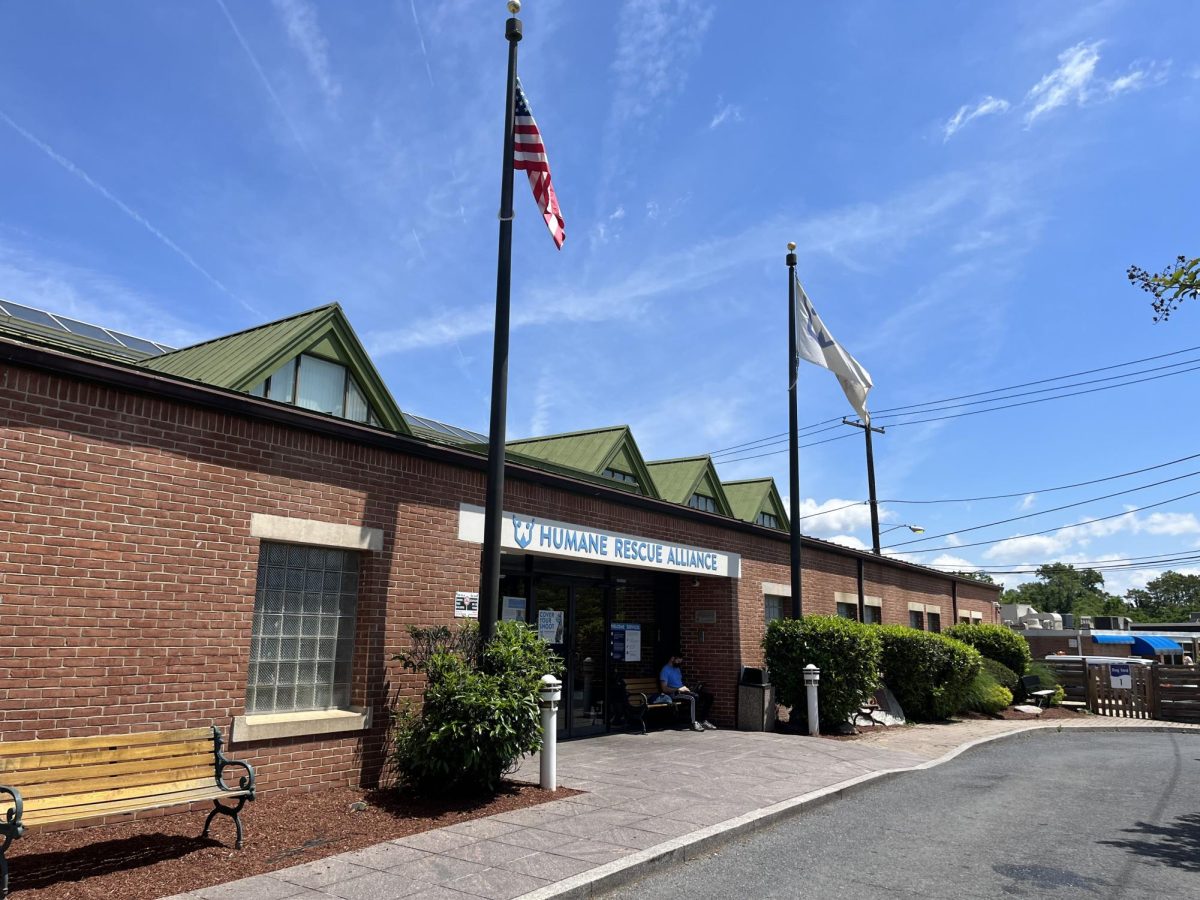“When I go to universities, particularly Jesuit ones, they usually have just one standard sort of paper,” Raymond Schroth, S.J., observed. “A university that can produce enough writers to put out more than that should be proud of itself.”
And Fr. Schroth should know. He was instrumental in creating the Georgetown Voice, some 36 years ago.
A recently ordained Fr. Schroth was beginning doctoral studies at George Washington University and writing a thesis on newspapers. He was living in Ryan Hall, the old Jesuit residence where students lived as well. One of these students was Steve Pisinski (CAS ’71) – tall, slender, blond and conservative.
“I remember the first time I met him,” Schroth recalled, “he came by my room and asked where he could get a Latin mass.” The mass had been changed from Latin to English just the year before, but Pisinski could not quite bring himself to break from the tradition.
They were an unlikely duo to have founded the Georgetown Voice – a liberal priest and a conservative Hoya writer from assachusetts. But their bond and their passion for journalism led them to do exactly that.
Ryan Hall had small floors and the students on those floors got to know each other very well. Pisinski, Fr. Schroth and the other students on the floor became fast friends. By Pisinski’s sophomore year, he had grown dissatisfied with The Hoya. “He felt like he wasn’t getting the creative freedom he needed,” Schroth explains. It became a subject of conversation.
Schroth introduced Pisinski and his friends to new journalism, where the personal interpretation of the author played a prominent role. Tom Wolfe had just penned the Electric Kool-Aide Acid Test, introducing college campuses to the hippie movement and new journalism with one stroke of the pen. Schroth showed them copies of the Village Voice, the New York newspaper just entering its heyday as a flagbearer of new journalism.
Ryan Hall would hold occasional parties, not only inviting their friends but also faculty and administrators to the hall to mingle. Schroth recalls being approached by the director of student activities at the time who said, “If you and some of these students want to start another paper, I can find the money for it.” Schroth accepted immediately.
“I spoke to Steve and we just got to work.” Schroth and Pisinski rounded up a group of editors. According to Schroth, about half of the original staff was from that floor in Ryan.
On Feb. 13, 1969 a story on page 11 of The Hoya announced the formation of the group. The editors of The Hoya didn’t think this publication was something that was going to last, noting flippantly in their story that, “Whatever the fate of the Georgetown Voice, it appears to have secured at least one form of acceptance – – Hoya Station has issued it a post office box.”
On March 4, 1969, the first issue of the Voice arrived on campus. Its lead story was an investigation on the Kerner Report, which claimed that America was moving toward two societies, “one black, one white – separate and unequal.”
The issue also featured contributions from four senators and four house members, including George McGovern, who ran unsuccessfully for president three years later and a story on the “auspicious debut” of Led Zeppelin.
Donald Casper (CAS ’70) was the editor in chief of The Hoya. And he was bitter – Steve Pisinski had been one of his star news writers.
Uneasy Lies the Head that Wears the Crown
In the office of The Hoya’s editor in chief, scrawled upon the wall in black marker, an epitaph of the insane, is the phrase, “uneasy lies the head that wears the crown.” In the history of the paper, few editors felt this as acutely as Don Casper.
Unlike Pisinski, Casper remained a self-described “hard-bitten conservative.” The mood of a college campus in 1969 was such that it was difficult for a college student to hold onto conservative ideals. Protest movements were going full steam at Berkeley and at the Ivy League schools, but Georgetown’s was just getting started.
Although Schroth does not recall Steve expressing any particular tension with Casper, Casper remembers a few specific disagreements. In early 1969 Pisinski had asked to cover a counter-inauguration being held on the national mall a few days before the real inauguration. Instead of endorsing Nixon in any way, shape or form, the protesters inaugurated a pig as president. Pisinski was extremely displeased, Casper says.
The event highlighted their differing approaches toward journalism. The Hoya had traditionally focused on campus and university events. “With respect to national and international events – we had tough competition with the Post and the Times,” Casper argues.
But Steve Pisinski saw it differently. He believed that national and international stories could have great value if reported from the student viewpoint. Casper insisted that paper should not cover events from any point other than saying what happened.
Casper’s unease was compounded by another frightening event that happened earlier in the year. That same winter, the freshman class had voted to separate from the Yard and form a unified student government. It was the death knell for the Yard, which fell apart within the year.
Casper recognized the significance of the event, but that same week the university announced an across the board tuition increase, and Casper gave that top-billing in the newspaper. The freshmen who left the Yard were furious at Casper and stormed The Hoya office demanding better coverage. These freshmen were hot stuff. The bottom of The Hoya cover was not good enough for people of this importance!. Casper disagreed.
The group of students, approaching 50 in number, stood outside of The Hoya’s offices and burned Casper in effigy. The not-so-brilliantly-considered fire became legendary for nearly igniting the Ryan Administration building.
And Casper had become a dirty word on campus. Angry groups began two ad hoc, ragtag publications, The Hoya Rag and The Hoya in Exile. The Hoya Rag lampooned The Hoya’s wildly criticized editor as “the avid Casper.”
When the Voice hit campus it seemed like another knife in the back.
The Introduction of a New Political Word
In March of 1969, the era of radicalism really hit Georgetown University, and Don Casper had accidentally helped usher it in.
One of the hottest rising stars in the Democratic party was Joe Alioto, the newly elected mayor of San Francisco. Casper, also a San Franciscan, invited Alioto to speak on campus in Gaston Hall. About a dozen California congressmen were in attendance. As were many Washington luminaries looking for their first glance at Alioto.
Also in attendance was an angry, but small, student organization – the Students or a Democratic Society. The SDS was a group of students who all lived at 3611 Prospect Street. There were not enough students in the organization to stage much of a protest, so the leaders of the SDS called in their friends.
The Rev. Edward Bodnar, S.J., who was The Hoya’s moderator at the time, remembers sitting near the doors to the auditorium, “It was scary. Right next to the doors to the auditorium, lined all the way through the hall, many kids, not more than five of which were Georgetown students, were dressed in military fatigues. They were pressing against the doors, but being blocked.”
Casper took the stage to introduce Alioto to the audience. During his introduction, Emilio Gonzalez, a sophomore in the college and a veteran of Vietnam attending Georgetown on the G.I. bill, rushed the stage and demanded the microphone.
Gene Payne (CAS ’69), then associate editor of The Hoya, says the microphone was yielded, believing that Gonzalez would say his piece and the event could continue.
“Let me introduce you to a new political word,” Gonzalez bellowed. “Mother fuckers.”
This likely marked the first utterance of the phrase in Gaston and the first occurrence of the phrase in The Hoya when the story was covered. All hell broke loose before the audience had a chance to be stunned. The protesters broke through the doors to Gaston, rushed the stage, knocked down the podium and microphone. In the chaos that followed, one of the Chimes, there to sing the Alma ater, was knocked into the light switch. Gaston plunged into darkness.
A dozen panicked members of Ccongress likely never returned to Georgetown. Casper, Alioto and a small group of students escaped out the back of Gaston Hall, and down the fire escape by Old North, at the time a rickety old iron spiral.
Georgetown, a Two-Newspaper Town
The event was seared in the minds of everyone there. The Washington Post described the Alioto speech as the “disgraceful episode at Georgetown University” and called the SDS a “handful of young hooligans.” Harsh words from the Post.
Hoya editors Gene Payne and Don Casper, and the moderators of the papers, Fr. Schroth and Fr. Bodnar, all retain vivid memories of the evening. Everyone condemned the chaos in Gaston Hall.
The Voice called the SDS a joke and wrote that “the moment it indulged in violence it ceased to be funny and instead became disgusting.” But, the paper proceeded to remark, ominously, “nevertheless if the university should stifle legitimate dissent it should expect more violence.”
Gene Payne observes that the Voice “had found a niche that had a certain appeal to it in those days.” Many students at Georgetown agreed and wanted to get on board.
By the Voice’s second issue the listed staff had doubled from 14 to 28 members. When The Voice entered its third year of publication, the staff, now a robust 48 members announced the intention of the Voice to become a weekly newspaper but also felt it necessary to affirm the Voice’s “commitment to objective journalism.”
Bob Hayes, who served as The Hoya’s editor in chief in the spring and fall of 1972, said that by the time he became editor in chief the ideological differences had converged. The Voice moved a little toward the center, and The Hoya moved quite a bit to the left. By the time Hayes took over, The Hoya was an anti-war, liberal editorial paper.
Hayes believed that for financial reasons The Hoya and the Voice should merge. In 1973 the papers had several meetings, but the negotiations fell apart – “not because of political differences but because of personalities and fiefdom more than anything,” Hayes explains.
Fr. Bodnar, who remained the moderator of The Hoya into the late ’70s recalls the effect it had on the staff. “It was healthy competition. It was the eventual motivation for [The Hoya] coming out twice a week.”
Hayes agrees, “Competition is great. There is a reason two paper towns are better than one paper towns.”
Casper still harbors some strong feelings about the Voice. Casper recalls, “I picked up a copy of the Voice outside of Yates [a few years ago]. I was delighted to see that it was a decidedly inferior product.”
Epitaph
About ten years after graduating Steve Pisinski moved out to San Francisco, where he and Casper were both members of the Republican Party. For years Pisinski and Casper avoided each other until they quite literally bumped into each other at a crowded fundraiser.
Casper stammered, “Steve . I didn’t mean to bump into you.”
“No problem, I didn’t spill my drink,” Pisinski replied.
It was the start of a friendship. Casper became chairman of San Francisco’s Republican Party, and Steve remained a dedicated Republican, they remained friends until Steve Pisinski died suddenly of a heart attack on May 14, 2002.
Casper fondly recalls dinners with Pisinski and his family and came close to boasting of Pisinski’s success as the founder of a public relations firm, The Montgomery Group.
Fr. Schroth, the co-founder of the Voice, remembers, “He was very bright, very hard-working and had a gift for friendship. Steve was a very beautiful person, and I still miss him.”







